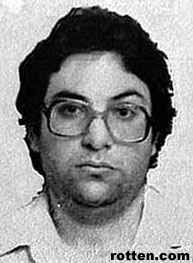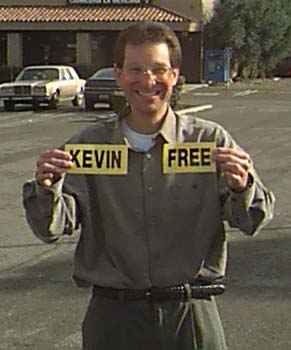|
Kevin Mitnick Kevin Mitnick stands as one of the ultimate examples of the classic quandry: if someone commits a crime, and then is fucked over so much and so hard for it that the original crime seems like a trifle by comparison, who has done more wrong?
Kevin Mitnick stands as one of the ultimate examples of the classic quandry: if someone commits a crime, and then is fucked over so much and so hard for it that the original crime seems like a trifle by comparison, who has done more wrong?
Mitnick's history with computers is long and varied. By 1980 he was already getting a name for himself as another annoying kid on computer bulletin board systems, using the handle "The Condor." Mitnick learned the ins and outs of various computer systems, and began using his lower-register voice and lopsided social skills to get passwords and other restricted information from companies. This technique, called "Social Engineering," has become his most famous trademark. Mitnick was supposedly the model for the David Lightman character in the movie Wargames (1984). In fact, the screenwriters had never heard of him when they created the movie. Accompanying the time of Wargames were a number of infamous busts and publicized crimes regarding computer hackers; they were quickly becoming an archetype, evil and nefarious, located anywhere there was suburbia and a home computer. Things started getting out of hand, and media claims of the power of computer hackers, wild as they were, became an overriding theme as more busts occurred. Mitnick was walking in and out of systems very easily by the mid to late 1980s, but was starting to see about gaining employment in the field as well. Unfortunately, his life caught up with him before he could go "legit". He was busted in 1987 for invading a computer system at a company called the Santa Cruz Organization. The original charge was a felony, but his lawyer got it knocked down to a misdemeanor, and Mitnick was given a three year probation. The next year, however, he was ratted out by a friend (who, admittedly, was rightly pissed that Mitnick was hacking from his computer), and Mitnick was arrested for breaking into Digital Equipment Corporation and taking some of their source code. The court case at this time got some notoriety because of Mitnick's lawyers claiming that their client had an unstoppable "computer addiction" that required counseling. He was convicted but given a "lesser" sentence of a year in prison. That year in prison taught Mitnick one thing: how much prison could suck. The legend and myth surrounding Mitnick at this point was so great, that the warden of the Lompoc Jail was convinced by the authorities that Mitnick could hack into computers using just his voice and a phone. As a result, Mitnick had huge, amazing restrictions put on him while in jail, and in fact spent the vast majority of it in solitary confinement. Mitnick was allowed few visitors, and went a little crazy in there.
For the next two years, Mitnick went on the lam, using his considerable skills to forge a new life, making new identities and changing his personal habits constantly so as not to be tracked. He was spotted in Seattle and in other locations. By this point, of course, the "Mitnick Legend" was in full swing; he was the cyber-ninja of all time, able to glance at a TV set and make it hack into the Pentagon. Most observers of this entire fucking mess say that what turned Mitnick into a sad case of a computer-hacker-turned-fugitive into the World's Most Wanted Computer Criminal were a series of sensationalist articles by John Markoff of the New York Times, who called Mitnick nearly every name in the book. The articles often ran front-page, and painted a man who was deadly, unstoppable, and a top-ten wanted man by the FBI and anyone else with a badge and a gun. By the time these articles had run in the Paper of Record, Mitnick was a marked man and his future as an "Example" was assured. The back-and-forth regarding Mitnick's actions and the actions of those trying to catch him are a bit too complicated for this entry, but don't look for accuracy in books by Markoff and Katie Hafner, Markoff's ex-wife. Suffice to say, during the two years that Mitnick spent on the run, the drum-beat got louder and the parties involved became more and more intertwined. Mitnick was finally apprehended (barely) by the FBI in North Carolina in 1995, when he answered the door at his apartment to find a number of agents crawling around. The bust was particularly problematic because in one of the vans outside the complex was John Markoff, who had been helping the FBI with their investigation. Markoff used this questionable position as both reporter and co-investigator to put himself at the center of a federal bust and investigation, which almost nobody says is within ethical bounds. Finding Mitnick had been the goal of a highly intelligent jerk named Tsutomo Shimomura, who himself was not exactly the most ethical of creatures. Shimomura's answering machine had contained pissed-off crank calls from someone who claimed to be Mitnick (now long since proven not to be) and several hacks had occurred at machines that Shimomura used. It is generally agreed that Shimomura's arrogant, self-aggrandizing part in the investigation likely sped up Mitnick's capture. The court case against Mitnick was completely and entirely whacked. The FBI encouraged victim corporations to inflate loss estimates by tens of millions of dollars and prosecutors tacted on many extra felony charges. In some cases, the "damages" for the software that Mitnick allegedly copied included the cost for all the hardware, salaries, and buildings that were used to write the software. Mitnick and his legal team were not allowed to see much of the evidence against him. The newspapers crowed and crowed about his many crimes and the incredible mastermind of evil and damage that Mitnick had been (most of it inspired by the Markoff/New York Times articles). And then came the worst part of all.
Mitnick eventually pled guilty in a deal where his four served years would apply against a five year sentence. When he was released from prison, his story was not over: a condition of his release was an absolute ban from any sort of computer use. For years, Mitnick could not own a home computer, type using a word processor, receive or send e-mail, or even touch a computer keyboard. The comedic aspects of this limitation in the modern world were never lost on Mitnick, and as he put his life back together, Mitnick co-wrote a book called The Art of Deception, which he cranked out on a manual typewriter. In 2003, Mitnick was finally released from supervision and can use the Internet and computer technology of the 21st century. Back up your files! Just kidding. Meanwhile, Markoff sold the ludicrous book he wrote with Shimomura ("Takedown") to Miramax as a fictional film. The film has little to do with reality; the Mitnick character physically assaults the Shumomura character (they never met) and whistles into a phone to hack into a computer (which can't happen), and generally just pulls stuff out of its ass. Between the book and movie, it is said that Markoff cleared a million dollars. No doubt he could afford some Sominex to help himself sleep at night. |
 Released from prison in 1989, Mitnick tried his hand getting into various jobs, but the one that stuck was working as an info-gatherer for a private investigator. Naturally this put him back into the grey and black markets, and it wasn't long before the
Released from prison in 1989, Mitnick tried his hand getting into various jobs, but the one that stuck was working as an info-gatherer for a private investigator. Naturally this put him back into the grey and black markets, and it wasn't long before the  Mitnick's trial didn't happen for many years. Four in fact. He was held without bail (because of his flight risk) and as the government and authorities dragged their feet assembling evidence against him, Mitnick languished in prison. Four years without bail, trial, or charges listed against him. If nothing else, Mitnick remains as one of the worst constitutional abuses by the prison system in modern times. And therefore, the question is asked again: for all the amount of trouble he caused and the crimes he was alleged to commit, was holding him for nearly half a decade without any opportunity for him to view the evidence against him justified? The answer, to anyone reasonable, is likely no.
Mitnick's trial didn't happen for many years. Four in fact. He was held without bail (because of his flight risk) and as the government and authorities dragged their feet assembling evidence against him, Mitnick languished in prison. Four years without bail, trial, or charges listed against him. If nothing else, Mitnick remains as one of the worst constitutional abuses by the prison system in modern times. And therefore, the question is asked again: for all the amount of trouble he caused and the crimes he was alleged to commit, was holding him for nearly half a decade without any opportunity for him to view the evidence against him justified? The answer, to anyone reasonable, is likely no.